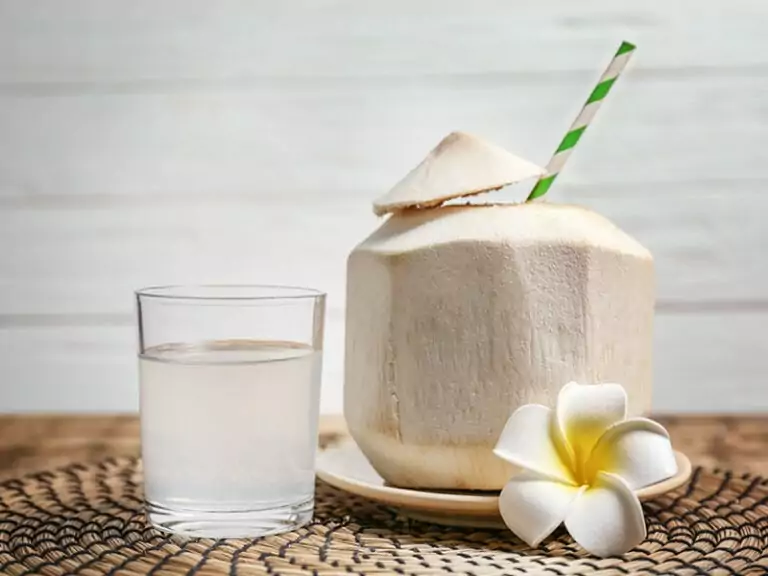Both Turkish drinks and Turkish foods have a long history, spanning multiple centuries and empires. Most of their dishes are from multiple cultures, from Mesopotamia, where civilizations started, to the wild steppe of Central Asia and even as far as the Mediterranean.
You can find many types of drinks within the country: Some are milked-based, some are fruit-based. And most surprising of all, despite being a majority Muslim country, alcoholic drinks are very popular.
In order to help you understand more (and maybe make one of these drinks as well), I’m going to show you some of the most iconic Turkish drinks. This will help you understand how much geographical diversity has turned Turkish cuisine into what it is today.
Well, enough hanging around, let’s get sharted!
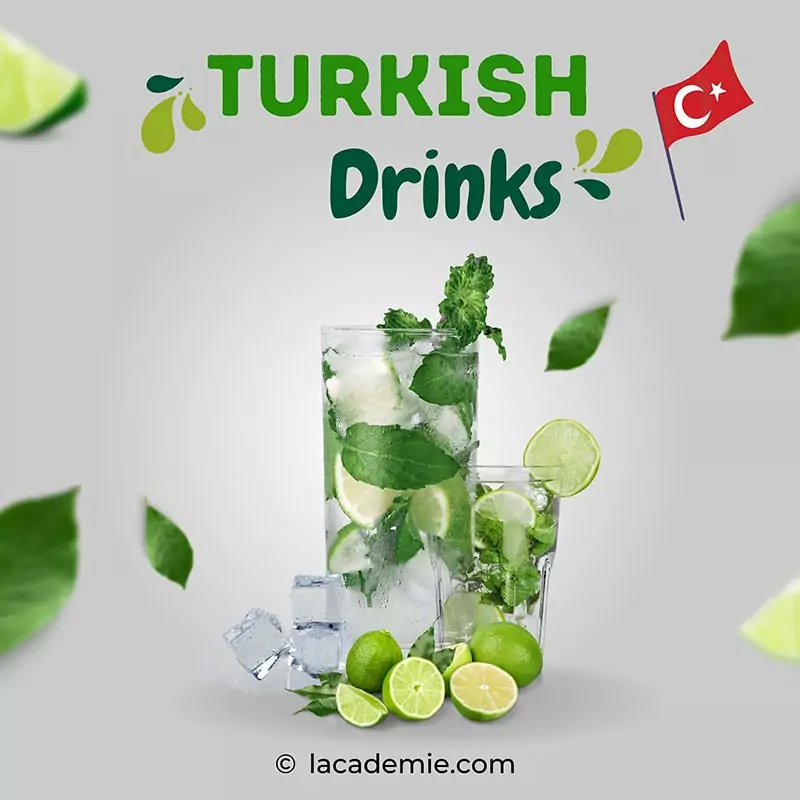
Turkish Dairy Drinks
Let’s start this off with a list that everyone in your family can enjoy. Dairy drinks are very popular with Turkish people because they are delicious and can provide good energy in the morning. And you can make these drinks at home with the right ingredients.
1. Kefir
(Turkish Fermented Dairy Drink)
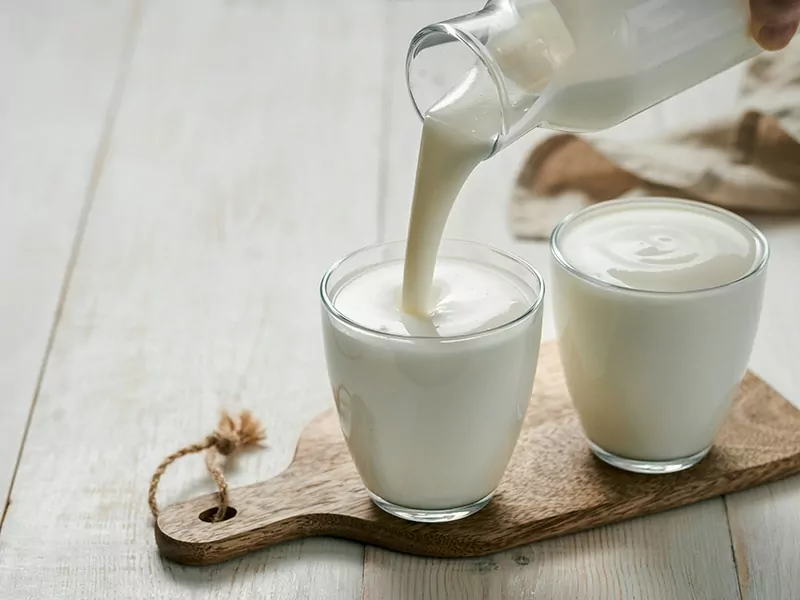
Kefir is a type of fermented milk, very similar to yogurt. It mostly comes from the North Caucasus region (North Turkey, Armenia, and Georgia). The main ingredient for the drink is cattle milk, along with a mixture of yeast and bacteria called the Kefir grains.
In Turkey, there are two well-known fermented dairy drinks: Kefir and Ayrani. Kefir is thicker and more sour compared to Ayrani. Plus, people like to combine Kefir with different flavors. If you are curious about Ayrani, I will go further into details in the next entry.
In order to make Kefir milk, you have to add milk into the Kefir grains. The amount of Kefir should be at around 2-5% compared to the milk. After that, pour everything into a jar and leave it for at least 12 hours. You need to store it somewhere dark, with a temperature of 68°F (20°C).
After 12-24 hours, you can finally take the jar out and strain out the grain to use for another batch. You can drink the Kefir milk after that or keep it fermenting for longer.
Unsurprisingly, thanks to the fermentation process, the Kefir is very healthy for human consumption. In fact, studies have shown Kefir has a lot more nutrients than regular yogurt. Kefir has a lot of nutrients, probiotics and it can even improve your bone density.
Kefir has been getting more popular in the West due to the drink’s nutritious values. The next time you want a refreshing drink for your diet, you know where to find it.
Where to buy: The drink is almost everywhere in Turkey, you can find both street vendor versions and supermarket versions.
2. Ayran Yogurt

Yogurt is a very popular Mediterranean dessert, but sometimes it can be too sweet during a meal. What if there was a way you could have it as a savory treat? Well, let me introduce you to Turkish Ayran yogurt. It is a type of special yogurt that has water and salt.
Ayran yogurt originated from many Turkic tribes in Central Asia. The drink first appeared as a “cold drink made from milk”. Due to the spread of Turkic people within the region, many countries call this drink by different names, including Doogh, Dhallë, and Daw.
Turkish people often have Ayran yogurt with meat or kebabs. In many Turkish restaurants, you can order one of these two types of Ayran yogurt: Acik Ayran, which is a homemade Ayran yogurt; Kapali Ayran, which is a bottled version of the drink.
In most places, people are making Ayran yogurt using machines instead of the old method. In the old Anatolia region, the old method utilizes a butter churn. People often refer to this type of Ayran as Yayik Ayrani. You can find out about it in the next entry.
Ayran yogurt has a lot of health benefits, including electrolytes, nutrients, and even minerals. The beneficial bacteria inside of the yogurt also improves your digestive tracts. If kefir is not to your liking, then Ayran yogurt can be a great replacement.
Where to buy: You can find packaged Ayran yogurt in any Turkish supermarket. It’s also available as a popular street food across Turkey.
3. Yayik Ayrani
(Turkish Buttermilk)

Now, we will go further into Yayik Ayrani or Turkish buttermilk. Despite the similar names, Yayik Ayrani and Ayran yogurt are different types of drinks.
The name of the drink comes from the butter churn, which means “yayik” in Turkish. Turkish carpenters often use wood, animal skin, or metal to make “yayik”. On the other hand, “ayrani” means buttermilk in Turkish. Most of the time, cattle milk is its main ingredient.
To make it, farmers pour yogurt into the butter churn. Then, they add cold water to the yogurt. The ratio is 1 cup of yogurt and ½ cup of cold water. After they add everything into the yayik, the farmers start shaking the butter churn. This causes a layer of buttermilk to appear.
Aside from the buttermilk, Turkish people also collect cheese from the churning process. People often have Yayik Ayrani during breakfast. This drink is becoming less common since people prefer to make Ayran yogurt instead.
Where to find: Since Yayik Ayrani is mostly available in rural Turkish towns, you cannot find it in big cities. You can still find it in local markets.
4. Salep
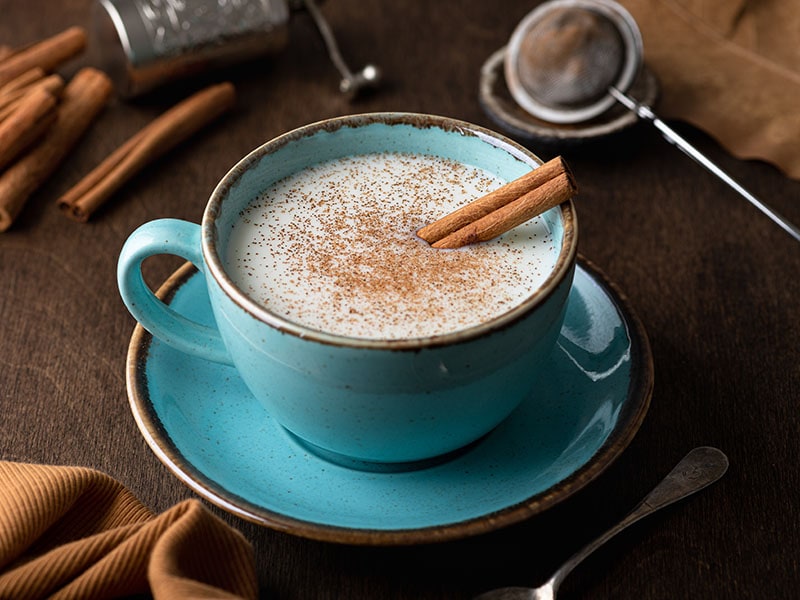
Salep is another good drink if you want a good pick-me-up in the morning. The main ingredient is Salep, which is flour made from the roots of a Turkish orchid genus. This flour is very nutritious. That’s why the old Ottoman Empire used it in drinks.
Fun fact, during the age of the old empire, young women often drank Salep as a way to make them a little thicker. This tradition helped women become more attractive before marriage.
In modern days, baristas and bakers add Salep into their drinks and desserts. One of the most popular beverages that use Salep is Turkish hot milk. First, the baristas pour in a cup of milk. Then, they add a tablespoon of Salep flour. Finally, they heat the mixture up.
The hot milk often has sprinkled cinnamon powder on top to add that slightly sweet and woody flavor. You can drink it as it is or have hot milk with Turkish pastry like rice pudding or baklava.
In modern times, Salep is often a popular breakfast beverage at many cafes. However, this means not many people make this drink at home anymore.
Where to find: You can get a cup of Turkish hot milk at a majority of coffee shops in Turkey. It’s fairly affordable.
If you don’t know how to make Salep, this video is perfect for you.
Turkish Tea
Aside from dairy drinks, Turkish people love to have tea in the morning. Tea has a soothing effect. It can help you start your day with the best mindset. That’s why I also want to introduce you to some of the most notable Turkish tea:
5. Black Tea

Turkish tea, also known as Rize tea, is a particular type of black tea found in Rize Province of Turkey. The region is mostly on the wetter side of Turkey, which is perfect for growing tea leaves.
In 1912, farmers harvested the first batch of tea leaves. In 1945, the government decided to encourage tea growing in the region. Thanks to this, the Rize region became one of the most critical regions for tea production in Turkey.
Rize tea has a very red color, and the taste is quite strong and bitter. Usually, if you order this drink in a teahouse, the waiter will serve it with a cube of beet sugar. The tulip-shaped tea glass, called “ince belli bardak”, keeps the tea from turning cold quickly.
The redder the tea, the better its taste. That red hue also has its own name, “tavsan kani”, meaning “rabbit blood”. Other than drinking in its pure form, you can mix Rize tea with Yayik Ayrani or regular cream.
Fun fact, most Turkish tea houses don’t allow women. However, women can go to tea gardens to enjoy some tea.
Where to find: This type of black tea is available in tea houses or sold commercially in a packet.
6. Nane Limon

If you prefer a much milder tea to have in the morning, then I can introduce you to the Nane Limon. This unique type of tea is somewhat tangy, yet it is very refreshing if you drink it hot on a cold morning.
The drink does not have a clear origin, but many Turkish households have been making it for a long time. The process of making this drink is rather simple. First, you squeeze 2-3 lemons into a cup. The lemon needs to be fresh for the flavor to fully extract itself.
After squeezing the lemons, you add one and a half tablespoons of sugar. You can adjust the amount of sugar based on your preference. Then, mix everything up until you fully dissolve the sugar. After that, add in 3-4 mint leaves.
The final step is to add hot water to the glass. The hot water will release the minty flavor from the leaves into the drink. In colder temperatures, you can drink this hot. If you live in a hotter climate, just do the same steps as above but add a few ice cubes into the drink.
Where to find: This drink is easy to make, so street vendors tend to sell it everywhere in Turkey. However, Turkish families also make it at home.
7. Elma Cayi
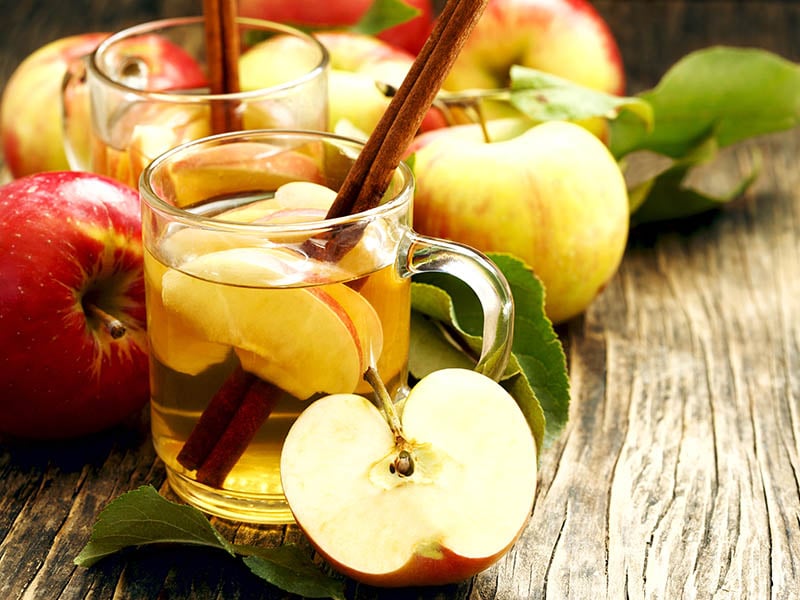
Continuing the love of tea drinking in Turkey, I will introduce you to another unique tea. Apple tea is quite popular in the Northern region of Cyprus. The drink’s main ingredient is dried apple instead of tea leaves.
In order to make this drink yourself, you need to use apples with a sweet and robust flavor. I would suggest Granny Smith or Macintosh. After choosing your preferred apples, chop them into small pieces and put them into a pot of water. Add in a cinnamon stick and boil everything up.
Once the mixture is bubbling, strain the solid bits out. Finally, boil it for around 1-2 minutes more before taking the pot off the stove.
In Turkey, you often have this drink with sugar cubes. In other places, you can ask for both sugar and cream.
Where to find: You can find apple tea in hotels or places where tourists often visit. The dried version is available as a gift.
8. Pomegranate Tea
Non-alcoholic

The final type of tea I want to show you is also one of my favorites since it is very easy to make, and you don’t have to spend a long time trying to pick out the perfect ingredients.
Pomegranate tea is very popular in Turkey as a health drink. The pomegranate itself has a lot of nutrients. Aside from that, consuming pomegranate or pomegranate-related products will strengthen your heart and reduce blood pressure.
How do you make pomegranate tea, then? First, you need the juice of 1-2 pomegranates. Pour it into a pot, add a cup of water. Then, you need to boil the liquid while adding 1 squeeze of lemon. Once everything comes to a boil, take the pot off the heat.
Additionally, you can add honey or sugar to sweeten the drink. But you can also drink it straight as well.
Where to find: Most teahouses in Turkey will have this drink. Pomegranate tea is also available in convenient pre-made packets.
Turkish Coffee
Aside from both dairy and tea products, coffee is a popular drink in Turkey. However, unlike other countries, Turkish people love to drink their coffee after meals instead of in the morning. I will be introducing you to two types below:
9. Unfiltered Coffee

Turkish coffee is very different from any coffee you can find in the world today. One of the biggest differences is that you don’t filter out the ground coffee inside the pot. Instead, most Turkish people drink ground coffee as well.
The coffee-drinking culture in Turkey has existed for a long time. In fact, the first-ever coffeehouse in Turkey was opened back in Istanbul in 1555. The coffeehouse was where most scholars met up to discuss politics, education, and philosophy.
Turkish coffee is important as an after-meal drink. It also appears in many events and ceremonies. People often serve it during meetings and wedding engagements. In an engagement, the bride will serve the groom’s family this coffee.
The traditional Turkish coffee recipe requires both coffee and water in a special pot called a “cezve”. Both ingredients need to come to a boil before the pot is off the heat. Once the boiling stops, the brewer places the pot back again, and the process needs to repeat two more times.
The result is a very earthy and smokey coffee. You can drink it raw like that, or you can add a bit of cream to counter that charred taste.
Coffee is a symbol of friendship, so you must accept the drink when others offer it to you. Fun fact, Turkish shamans can use the leftover coffee grounds to do fortune-telling.
Where to find: Turkish coffee is available in almost every street of Istanbul. You can also find this in coffeehouses in the city.
10. Kurdish Coffee

You can also call this type of coffee menengic or pistachio coffee. Instead of traditional coffee beans, roasters create this from ground roasted terebinth fruits. This fruit is similar to the pistachio, hence the name “pistachio coffee”.
The coffee itself is very popular in regions where the Kurdish people live, like Diyarbakır, Adıyaman, and Mardin. The Kurdish people, or Kurds, are an ethnic group living across Central Anatolia, the Caucasus, and Western Turkey.
If you are in the country and want to try an alternative to a traditional coffee, just come to these regions, you might be surprised at how good this coffee is.
Where to find: This is part of the Kurdish cuisine, so you might be able to find it in Kurdish enclaves within Turkey.
Turkish Fruit and Vegetable Drinks
Aside from tea and dairy drinks, Turkish people also make their drinks from many Turkish fruits and vegetables. You can find a lot of Turkish street food carts selling these drinks. The taste of the fruits and vegetables enhances the drinks even further. Plus, they’re pretty healthy.
If you’re a fan of juice and fermented fruit drinks, then this list will be where you need to look at the most:
11. Salgam Suyu
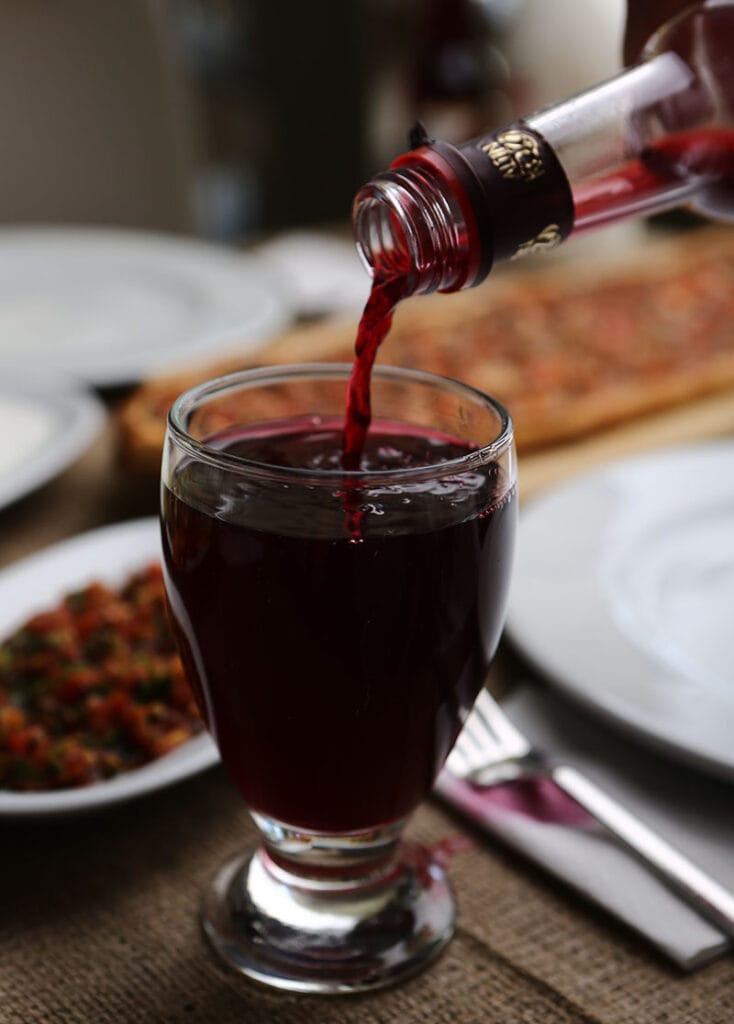
Turnip water, also known as Salgam Suyu, is a type of fermented vegetable drink. This drink is very popular in many Turkish cities, including Adana, Mersin, and Izmir. You can see this type of soft drink on many Turkish tables during meal times.
The first came to the attention of most Europeans during the 15th century, when a French writer named Pierre Belon described it in his journal. The drink often comes with another iconic Turkish drink called Raki, which I will discuss below.
In order to make this drink, the maker prepares a salty and sour brine solution. Then they add the vegetables, which consist of carrots and turnips. Of course, this is only the most general method of creating this drink since different makers have different recipes.
Turnip water has a lot of health benefits. First of all, the drink is a good hangover cure. This drink contains a lot of vitamins and minerals. It can help with digestion and remove kidney stones. Aside from that, people drink turnip water to reduce acne and eczema.
Depending on the makers, the taste of turnip water can vary. However, most would agree that the sweetness and tanginess of the turnip water should always be there. There are two variants: Acili (hot version) and Acisiz (plain version).
Where to find: The drink is very popular in many big Turkish cities. Most often, you will find a street vendor selling this. There are also pickled vegetable stalls that have the drink.
12. Limonata
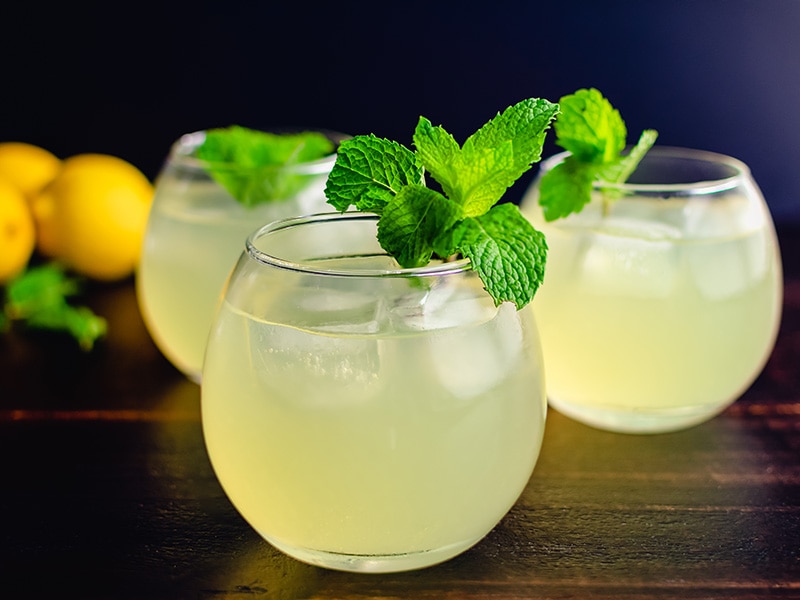
Another fruit drink you might want to try in Turkey is the Limonata. It’s the Turkish version of your simple lemonade, but with a Turkish twist. It is not only refreshing, but it’s also providing you with a lot of vitamin C.
The drink is very simple to make. You need to peel off the lemon skin. If you have a blender, put the lemon inside and blend it. But if there’s no blending, you can also put the lemon into a glass and squash it. Add sugar and hot water before mixing everything up.
What you have as a result is a nice glass of Limonata. To give the drink its signature Turkish flavor, add a bit of cinnamon to enhance the taste.
Where to find: You can find the drink at simple street vendors or even high-end teahouses.
13. Pomegranate Juice

During a hot Turkish summer, what better way to relieve that heat than to have a glass of pomegranate juice. Alongside Salgam Suyu, it is one of Istanbul’s most popular street foods. You can’t go anywhere without seeing a cart selling the drink.
The reason for its popularity is due to the drink being easy to make. The recipe of the pomegranate juice only requires two ingredients: pomegranate and sugar.
In order to make this, you need to squeeze the pomegranate into a glass, add a tablespoon of sugar and a cup of hot water. Sometimes, you can see vendors add orange juice to give a sour after-taste. The drink goes best with some ice.
Where to find: The pomegranate juice is sold on the streets of Istanbul.
14. Ottoman Sharbat

The Ottoman Sharbat, or Sherbet, is a type of fruit drink in many countries of the Caucasus and South Asia. Despite having “Ottoman” in its name, the drink actually originated from Iran in the 11th century.
Due to the past Muslim laws, Sharbat became a very popular beverage in the Ottoman Empire. The most common fruits used in Ottoman Sharbat are tamarind, grapes, and pomegranate. You can find a special Sharbat made with lemon during engagement ceremonies.
The taste is very sweet and sometimes sour, depending on the fruits. However, it is a very good drink if you want to cleanse your body.
Nowadays, Turkish people only make Sharbat during special occasions. The drink is trendy during Ramadan in Turkey and many Muslim countries. It remains one of the most popular parts of Turkish culture and reminds the Turkish people of their glorious past.
Where to find: You can find the drink only on special occasions like weddings or celebrations.
Turkish Cocktails
Although most Muslim countries prohibit the consumption of alcohol due to Sharia Law, Turkey doesn’t seem to follow it. It’s one of the very few Muslim countries that allow alcohol consumption, alongside Egypt, Lebanon, and Syria.
I am going to start this list off with three beautiful, tasty, and simple cocktails from Turkey. Most of these cocktails are inspired by their Western counterparts, but with a Turkish twist:
15. Turkish Delight
Alcoholic
The cocktail takes its name from a very famous Turkish dessert treat made from gelatin and sugar.
When you order this, you will be surprised at how sweet it looks. The murky color of the cocktail reminds you of the sugar coating from the real Turkish Delight.
The taste is also memorable to match. You can feel the sweetness from the syrup, yet there is a hidden kick from both the gin and the Creme de Cacao (a type of chocolate liqueur). The egg white adds a bit of richness to the whole drink.
Where to find: You can order the Turkish Delight at any high-end bar in the country.
16. Turkish Delight Martini
Alcoholic
The Turkish Delight Martini offers a new take on the usual Turkish Delight cocktail by adding a bit of Martini.
Appearance-wise, the cocktail doesn’t look that much different from the normal version. It still has that reddish hue, thanks to the rose water.
However, if you taste it, you will be much more surprised at how stronger this feels compared to the other version. The Martini adds a bit more depth to the cocktail.
If you are a stronger drinker, then this version might be for you.
Where to find: The Turkish Delight Martini is available in bars around most big cities.
17. Turkish Screwdriver
Alcoholic

The Turkish Screwdriver is a very interesting take on your usual Screwdriver cocktail. Instead of using vodka as a base, Turkish bartenders will use Raki instead.
Due to the change in ingredients, you will find that the drink has a bit more Turkish flavor in this version. The Turkish Screwdriver will leave you with a stronger after-taste.
This version of Screwdriver will be much more potent, with a hint of tanginess from the orange juice. If you’re not careful, it might make you drunk.
Where to find: Since it’s a variation of the normal Screwdriver, the Turkish Screwdriver will be on the menu of most Turkish bars.
Turkish Distilled Drinks
Turkey also boasts a very vibrant market for distilled drinks. If a cocktail is not what you want, I can also give you the option of choosing these two wonderful alcoholic beverage brands:
18. Raki
Alcoholic

Photo Credit: Yeni Raki by Javier Parra is licensed under CC BY 2.0
Raki is a fruit-based spirit made from twice-distilled grapes and anise. Not only a popular alcoholic drink in Turkey, but Raki is also available in many countries, from the Balkan to the Caucasus.
It is unknown when the Raki first appeared in Turkish history. However, in his journal, an Ottoman explorer named Evliya Çelebi said that he had seen Raki distilleries in various small towns in 1630. Most of the Raki made during that time was from home.
The main ingredient for making Raki is a grape spirit called Suma. It has a very high alcohol content of around 40-50%. That is why most people tend to have the Raki with a lot of water and ice to dilute the drink.
That is why in Turkey, people tend to have Raki with a glass of cold water on the side. More often than not, Raki acts as a base for many Turkish cocktails, like the examples above. Most Turkish people have Raki with seafood dishes and meze, a type of appetizer in Turkey.
Fun fact, Turkish people often call Raki the “lion’s milk”. The reason is because the drink will turn a milky white when mixing with water. In Turkish culture, lions represent strength and courage.
Where to buy: Since Raki is Turkey’s most well-known alcoholic drink, you will not have a hard time finding it in supermarkets and grocery stores. Many restaurants also serve the drink.
19. Efes Pilsen – Beer
Alcoholic

When you’re talking about popular alcoholic drinks in Turkey, one name must always be on this list, and that is Efes Pilsen. It is a product of the world-renowned Efes Beverage Group, the 11th largest brewer in the world.
The taste of the Efes Pilsen is very light, yet it still retains that refreshing lager feeling of most beer. The beer is very forgiving to beginner drinkers. It still gives you the kick, but not too strong to make it uncomfortable.
The drink has a market share of 84% in Turkey, easily dwarfing every competitor. Thanks to its timeless bottle design, Efes Pilsen remains a top product in the country. Aside from the traditional Pilsen, there are also many variants like Efes Dark, Efes Extra, etc.
Where to find: Efes Pilsen is available in every Turkish supermarket, you can get the purer version in bars and pubs.
Other Turkish Drinks
If none of the above drinks catch your interest, I can also introduce you to 4 more new drinks. This list includes cereal-based, nuts, and even carbonated drinks, so you can have a much bigger selection.
20. Boza

Boza is a type of fermented beverage that is mostly available in Central, Western Asia, and the Caucasus. The main ingredients for this drink are different for each country. In Turkey, wheat is the main ingredient.
Fermented grain drinks have existed for thousands of years. Even ancient civilizations like Sumerians and Akkadians mentioned “fermented drink” in their records.
In the past, you could only make Boza during cold months due to the grains being easy to spoil. However, thanks to modern technology and refrigerators, you can make it all year round.
Boza has a very thick consistency, with a low alcohol content (around 1%), so everyone of all ages can enjoy it. The drink leaves a slightly acidic sweet after-taste. The drink is very rich in carbs because of the wheat.
Where to find: You can find bottled Boza in supermarkets, you can also find a homemade version from street vendors.
21. Puerpera Sherbet (Lohusa Serbeti)

Lohusa Serbeti might not be something you would find on the street or in teahouses. Why? It’s rather simple. Because it is a special drink that Turkish families make to celebrate new mothers. A Greek beverage named “Kainari” is Lohusa Serbeti counterpart.
The tradition of offering Lohusa Serbeti after a birth supposedly comes from the old Byzantine empire. In this tradition, the new mother had something called “lochozema”, a type of broth. Soon, this tradition also spread to the Ottoman Empire and eventually, modern Turkey.
The drink consists of water, spices, and red food color. The red represents good health and good luck in Turkish culture. After the mother and her family drink the Lohusa Serbeti, they will gather around and pray to God.
Where to find: It’s not available commercially, you only can find it if you have a Turkish family member celebrating childbirth.
22. Uludağ Gazoz
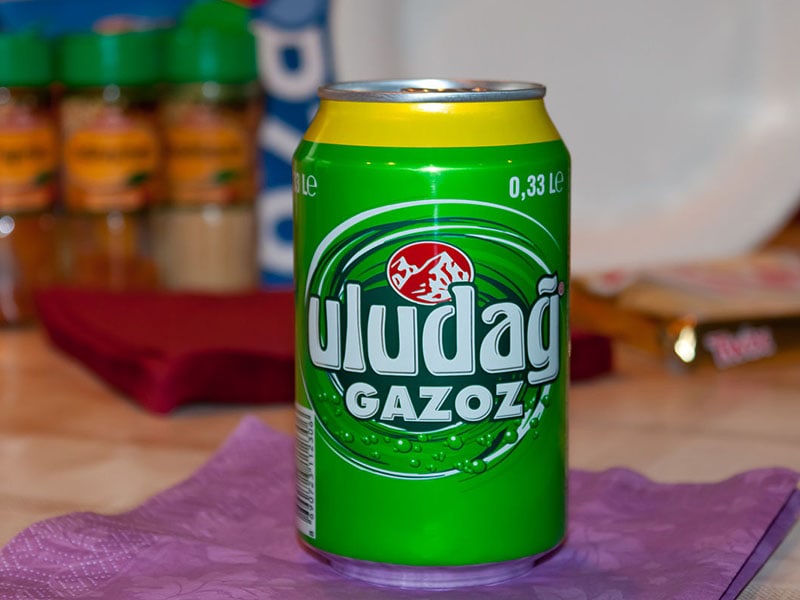
When you want to taste the real soft drink of Turkey, try Uludağ Gazoz.
While not as well-known as other carbonated drinks, Uludağ Gazoz is still very iconic in its own way. The drink is available in over 30 countries across the world. It is a type of lemon-flavor carbonated drink, similar to both Sprite and 7-Up.
The drink made its first appearance almost 100 years ago, in 1930. The creator, Erbak-Uludağ İçecek A.Ş, proclaims that it has been keeping the recipe for this drink a secret for four generations.
However, the company did reveal that they use the water in the Uludağ region and sugar from sugar beet to make the drink. The bottle is also an iconic part of the drink due to its curvy design.
Where to find: The drink is mostly available in grocery stores and supermarkets.
23. Turkish Coca-Cola

Everyone knows Coca-Cola, everyone is familiar with its history and even its taste. Most importantly, we know that Coca-Cola is the most popular soft drink in the world. However, did you actually know that Coca-Cola in each of the countries is different?
Yes, The Coca-Cola Company has to make their drink taste different in other countries. There are two reasons for this: First, the sugar content has to be lower due to domestic laws; Second, different cultures have different tastes.
That’s why when you go to Turkey, get yourself a bottle of Turkish Coca-Cola to taste the difference. In this case, you can find that the Turkish variant is a lot sweeter since the country doesn’t have a tax on sugary drinks.
So if you ever miss that classic sweetness of Coca-Cola, you can visit Turkey and get the Turkish version of the popular drink.
Where to find: Turkish Coca-Cola is available almost in every grocery store in the country.
Immersed In Turkish Culture Through Their Drinks
Turkish cuisine is very diverse since the region is a crossroad between multiple continents and cultures. That is why you will be able to taste all of that goodness without a clear understanding first. That is the purpose of this list today, to give you a glimpse of that diversity.
Hopefully, after reading this article, you can plan your next trip to Turkey and see how magnificent their culture, food, and drinks are. Maybe you can apply the knowledge from this list and impress even the locals.
If you like this article, please don’t forget to leave a thumbs up. And share this on your social media so other people can learn more about Turkish drinks. As always, have a great day!




